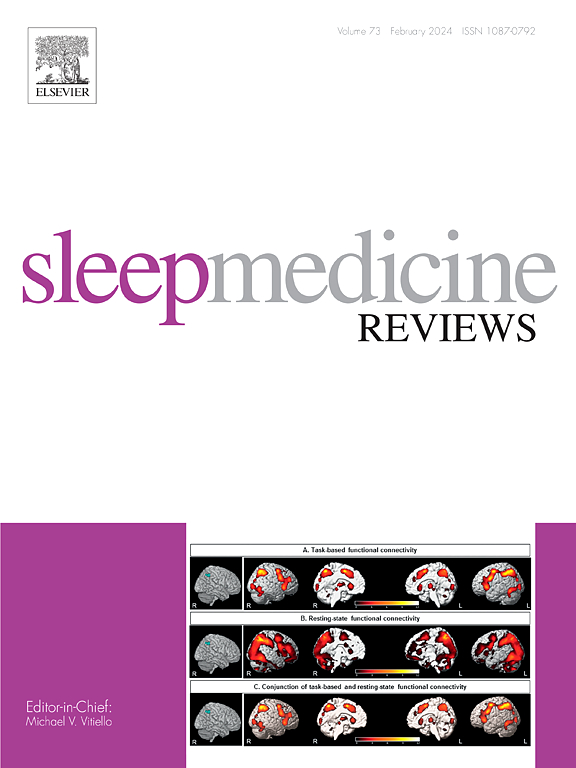Sleep alterations in major depressive disorder and insomnia disorder: A network meta-analysis of polysomnographic studies
IF 9.7
1区 医学
Q1 CLINICAL NEUROLOGY
引用次数: 0
Abstract
Major depressive disorder (MDD) and Insomnia disorder (ID) are characterized by sleep alterations. To define their polysomnographic profiles, we conducted a Network Meta-Analysis comparing MDD and ID patients versus healthy controls (HCs). The literature search, conducted from 2008 up to January 2023 and following PRISMA guidelines, covered PubMed, Web of Science, Scopus, and Embase databases. We addressed publication bias using funnel plot asymmetry inspection and Egger’s test, evaluated statistical heterogeneity with I2, and local and global inconsistencies with the separate indirect from direct evidence method and Q between designs, respectively. Pairwise meta-analyses employed a fixed-effects model, while network analysis utilized a random-effect approach. We evaluated 86 ID and 17 MDD studies, comparing sleep parameters for 636 MDDs versus 491 HCs, and 3661 IDs versus 2792 HCs. The network meta-analysis reported that patients with MDD have greater rapid eye movement (REM) sleep duration and REMs density, and lower REM sleep latency compared to IDs. ID patients instead exhibited lower total sleep time and time in bed, and greater wake after sleep onset and non-REM sleep stage 3 than MDD patients. This work emphasized sleep depth and continuity alterations in both MDD and ID, with major involvement of REM sleep in MDD.
重度抑郁症和失眠症的睡眠改变:多导睡眠图研究的网络荟萃分析
重度抑郁障碍(MDD)和失眠障碍(ID)的特征是睡眠改变。为了确定他们的多导睡眠图特征,我们进行了一项网络荟萃分析,比较MDD和ID患者与健康对照(hc)。文献检索从2008年到2023年1月进行,遵循PRISMA指南,涵盖PubMed, Web of Science, Scopus和Embase数据库。我们使用漏斗图不对称检验和Egger检验来解决发表偏倚问题,使用I2来评估统计异质性,分别使用间接证据法和直接证据法和设计之间的Q来评估局部和全局不一致性。两两元分析采用固定效应模型,而网络分析采用随机效应方法。我们评估了86项ID和17项MDD研究,比较了636例MDD和491例hc、3661例ID和2792例hc的睡眠参数。网络荟萃分析报告称,与中度抑郁症患者相比,重度抑郁症患者的快速眼动(REM)睡眠持续时间和REM睡眠密度更长,REM睡眠潜伏期更短。相反,与MDD患者相比,ID患者表现出更少的总睡眠时间和卧床时间,并且在睡眠开始和非快速眼动睡眠阶段3后醒来时间更长。这项工作强调了重度抑郁症和轻度抑郁症的睡眠深度和连续性改变,其中重度抑郁症主要涉及快速眼动睡眠。
本文章由计算机程序翻译,如有差异,请以英文原文为准。
求助全文
约1分钟内获得全文
求助全文
来源期刊

Sleep Medicine Reviews
医学-临床神经学
CiteScore
20.10
自引率
3.80%
发文量
107
期刊介绍:
Sleep Medicine Reviews offers global coverage of sleep disorders, exploring their origins, diagnosis, treatment, and implications for related conditions at both individual and public health levels.
Articles comprehensively review clinical information from peer-reviewed journals across various disciplines in sleep medicine, encompassing pulmonology, psychiatry, psychology, physiology, otolaryngology, pediatrics, geriatrics, cardiology, dentistry, nursing, neurology, and general medicine.
The journal features narrative reviews, systematic reviews, and editorials addressing areas of controversy, debate, and future research within the field.
 求助内容:
求助内容: 应助结果提醒方式:
应助结果提醒方式:


